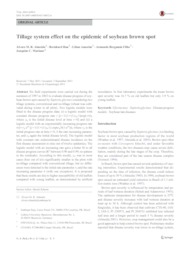Tillage system effect on the epidemic of soybean brown spot.
Tillage system effect on the epidemic of soybean brown spot.
Autoria: ALMEIDA, A. M. R.; HAU, B.; AMORIM, L.; BERGAMIN FILHO, A.; MARIANO, J. C.
Resumo: Six field experiments were carried out during the summers of 1997 to 2003 to evaluate disease progress of soybean brown spot caused by Septoria glycines considering two tillage systems, conventional and no-tillage (wheat was cultivated during winter in all plots). Two logistic models were fitted to the disease progress data: (i) a logistic model with constant disease progress rate r [y=1/(1+(1/y0-1)exp(-rt)), where y0 is the initial disease level at time t=0] and (ii) a logistic model with an exponentially increasing progress rate r(t)=r0 ebt [y=1/(1+(1/y0-1) exp(r0/b(1-ebt))), where r0 is the initial progress rate at time t=0, b the rate increasing parameter, and y0 again the initial disease level]. The logistic model with constant rate underestimated disease incidence on the first disease assessment in nine out of twelve epidemics. The logistic model with an increasing rate gave a better fit to all disease progress curves (R2 between 0.90 and 0.99; no pattern in the residuals). According to this model, y0 was in most cases (four out of six) significantly smaller in the plots with no-tillage compared with conventional tillage, but no differences were detected in the initial rate parameter r0 and the rate increasing parameter b (with one exception). It is proposed that these results are due to higher susceptibility of old leaflets compared with young leaflets, as demonstrated by artificial inoculation: In four laboratory experiments the mean brown spot severity was 16.7 % on old leaflets but only 3.9 % on young leaflets.
Ano de publicação: 2015
Tipo de publicação: Artigo de periódico
Unidade: Embrapa Soja
Palavras-chave: Doença de planta, Fungo, Soja
Observações
1 - Por padrão são exibidas publicações dos últimos 20 anos. Para encontrar publicações mais antigas, configure o filtro ano de publicação, colocando o ano a partir do qual você deseja encontrar publicações. O filtro está na coluna da esquerda na busca acima.
2 - Para ler algumas publicações da Embrapa (apenas as que estão em formato ePub), é necessário ter, no celular ou computador, um desses softwares gratuitos. Sistemas Android: Google Play Livros; IOS: iBooks; Windows e Linux: software Calibre.
Acesse outras publicações
Acesse a Base de Dados da Pesquisa Agropecuária (BDPA) para consultar o acervo completo das bibliotecas da Embrapa.

